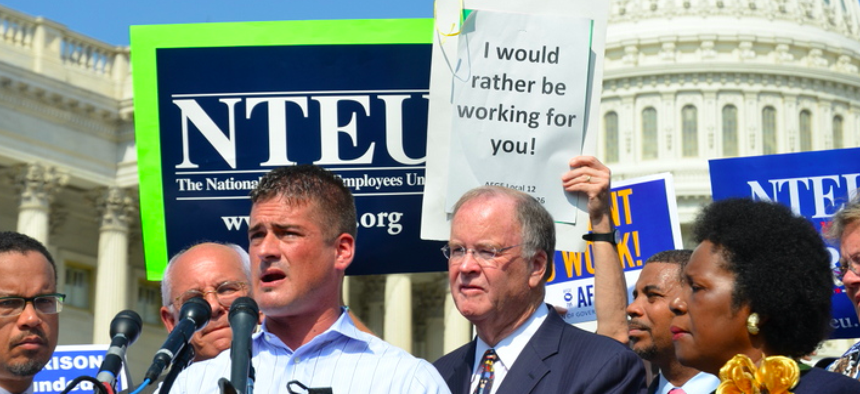
Federal employees protest the 2013 government shutdown. Rep. Keith Ellison, D-Minn.
What the Shutdown Means for Your Retirement
It affects everything from processing of applications to lump-sum payments for annual leave.
Due to the ongoing partial government shutdown, more than 300,000 federal employees are currently on furlough without a guarantee of back pay. An additional 500,000 are working but facing delayed paychecks.
Because the end of the year is a popular time to retire, some employees may have spent their last days on the job in a furlough status, and may be in the dark as to how their retirement processing is coming along. This information is also very important for people who are planning to retire or who are simply wondering about their benefits while waiting out the furlough period.
The Office of Personnel Management has posted guidance on shutdown furloughs and their effect on federal benefits. It contains insights from the 2013 government shutdown. (Of course, there’s no guarantee the current furlough will have the same end result as that one.)
Here are some highlights of the guidance:
- For retirement planning, a furlough period in a non-pay status is treated as a period of leave without pay. Employees receive credit for leave without pay periods up to six months in a calendar year without impacting their service credit for retirement or their high-three average salary.
- If your retirement was effective during the furlough period, you will be credited with service through your effective date of retirement as if there wasn’t a furlough going on. For example, if your retirement was effective on Dec. 31, 2018, you will receive service credit through close of business that day, but not beyond the date that you chose to retire.
- Keep in mind that there may be a delay in the processing of your retirement, because the employees responsible for finalizing your retirement package at your agency may be furloughed. That means they won’t be able to send your retirement application to OPM.
- Lump-sum payments for annual leave at affected agencies will be delayed until funds are available.
- If you are already receiving retirement benefits, you can make changes to your account online or by calling OPM’s Retirement Services unit at 888-767-6738.
- If you are already retired, the cost-of living adjustment due on Dec. 31 was included with your retirement payment on Jan 1.
Insurance and Other Benefits
For current employees, enrollment in the Federal Employees Health Benefits Program continues for up to a year in a nonpay status, and the government continues to pay its share of the contribution. The effective date of an open season enrollment change will still be the first day of the first full pay period in January for employees (Jan. 6 for most workers) and Jan. 1 for retirees.
Coverage under the Federal Employees Group Life Insurance program continues for a year for those in a nonpay status, without cost to the employee.
Health care expenses covered under flexible spending accounts will not be reimbursed until the employee returns to a pay status. Eligible dependent care expenses incurred during the nonpay status may be reimbursed up to whatever balance is in the employee's dependent care account, as long as the expenses incurred during the nonpay status allow the employee (or employee's spouse if married) to work, look for work, or attend school full-time.
Coverage under the Federal Long Term Care Insurance Program continues as long as premiums are paid. If Long Term Care Partners, which manages the program, does not receive any premiums for three consecutive pay periods, they will begin directly billing the enrollee. Coverage under the Federal Employees Dental and Vision Insurance Program will continue, but employees will get a direct bill for past due premiums if no premium is paid for two consecutive pay periods.
For information on the effect of furloughs on your Thrift Savings Plan account, see this fact sheet. You can make interfund transfers of your existing account balance during the furlough period, and you may be entitled to make up contributions when you return to a pay status. You can request an in-service withdrawal if you are age 59 ½ or older or if you are experiencing a financial hardship.
The shutdown should have little effect on Social Security checks. Most Social Security offices are open, and processing of payments continues because the agency has full-year funding in place.







